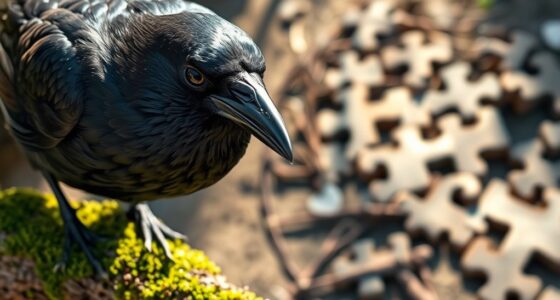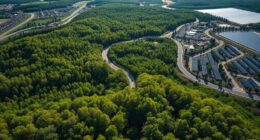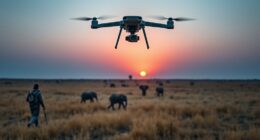Animals like salamanders, starfish, and certain lizards can regrow entire limbs, tails, and even parts of their hearts and brains. These remarkable creatures rely on specialized stem cells that activate after injury, rapidly multiplying to rebuild lost tissues seamlessly. Their regenerative abilities offer insights into survival strategies and potential medical advances for humans. If you’re curious, you’ll discover how studying these incredible animals can open new possibilities in medicine and healing.
Key Takeaways
- Many animals, like salamanders and starfish, can regenerate entire limbs, tails, or even organs.
- Stem cells play a crucial role in regenerating tissues and restoring lost body parts.
- Regeneration abilities vary widely among species, offering survival advantages.
- Some lizards can regrow their tails after injury, aiding in escape and balance.
- Studying these animals helps develop potential human regenerative and tissue repair therapies.

Many animals have the remarkable ability to regenerate lost body parts, a skill that often surprises and inspires scientists. This incredible capacity isn’t just fascinating; it offers insights into how evolution shapes survival strategies. When an animal can regrow a limb or tail, it gains significant advantages in escaping predators, repairing injuries, and maintaining functionality. These regenerative abilities have driven the development of various stem cell applications, paving the way for advances in medicine and tissue engineering. By studying these natural processes, researchers hope to *discover* ways to promote human healing and regenerative treatments.
Animals’ regenerative abilities provide valuable insights for advancing human healing and tissue engineering.
You might wonder how animals manage to pull off such complex feats. It all comes down to specialized cells called stem cells. These cells are versatile, capable of transforming into different tissue types needed for regrowth. When an injury occurs, stem cells activate and multiply rapidly, creating a foundation for new tissues to form. As the new tissue develops, it integrates seamlessly into the existing body structure. This process is highly efficient in animals like salamanders, starfish, and certain lizards, which can regenerate entire limbs, tails, or even parts of their hearts and brains. The ability to regenerate isn’t just about repairing damage; it’s an evolutionary advantage that enhances an animal’s chances of surviving and thriving in unpredictable environments. Regenerative capacity varies widely among species, reflecting different evolutionary pressures and adaptations.
From an evolutionary standpoint, regenerative skills offer significant benefits. Animals that can regrow lost parts often have a better chance of avoiding death from predation or accidents. For example, a lizard that can regrow its tail after a predator attack not only escapes immediate danger but also recovers a *vital* appendage that aids in balance and movement. Over generations, these abilities have become more refined, with some species evolving highly specialized regenerative mechanisms. This evolutionary advantage supports their persistence across diverse habitats and conditions. Plus, the study of natural regeneration informs stem cell applications, helping scientists develop therapies that could one day enable humans to heal more effectively. Imagine regenerating damaged tissues or organs, reducing the need for transplants or long-term treatments. Understanding how these animals control and activate regeneration may unlock new possibilities for human medicine.
Frequently Asked Questions
Can Humans Regenerate Lost Body Parts Like Animals?
You might wonder if humans can regenerate lost body parts like some animals. While our regenerative abilities are limited, advances in regenerative medicine show promise. Genetic factors influence how well your body heals, but scientists are exploring ways to enhance this process. Though we can’t fully regrow limbs yet, ongoing research aims to improve tissue repair and regeneration, bringing us closer to someday achieving more extensive healing capabilities similar to those in animals.
How Long Does It Take for an Animal to Fully Regrow a Body Part?
Imagine watching a tiny seed sprout into a towering tree—that’s how regeneration speed unfolds in animals. It varies, from quick growth in starfish, taking weeks, to slow, steady regeneration in salamanders, spanning months. You see growth stages like pages turning in a story—initial wound healing, tissue formation, and full restoration. The time depends on the animal and the complexity of the body part, but patience reveals nature’s incredible ability to rebuild.
Are There Any Animals That Can Regenerate Their Entire Body?
You might wonder if any animals can regenerate their whole body. Some creatures, like planarians and certain sea stars, can perform whole body regeneration, allowing them to grow into a new organism from a fragment. Their abilities inspire regenerative medicine advancements, showing potential for healing and tissue repair. While full regeneration isn’t common in most animals, studying these species helps scientists develop breakthroughs in medicine and understanding of regenerative processes.
What Environmental Factors Influence Regeneration Abilities?
Imagine a delicate balance beam, where environmental factors tip the scale. Your habitat impact and climate variation shape an animal’s regeneration ability, acting as both catalyst and obstacle. Warmer waters or stable ecosystems often enhance regenerative processes, while pollution or extreme conditions hinder them. You see, the environment isn’t just a backdrop; it’s a crucial player, orchestrating how effectively animals can heal and regrow, adapting to their ever-changing world.
Can Regeneration Ability Be Enhanced Through Medical Science?
You might wonder if regeneration ability can be boosted through medical science. Researchers are exploring stem cell therapy and gene editing to enhance your body’s natural healing. These advanced techniques could improve tissue repair or even regrow lost parts. While still in development, they hold promise for future treatments that could markedly increase your body’s regenerative potential, making recovery faster and more complete.
Conclusion
Just like a phoenix rising from its ashes, these animals remind you that renewal is always possible. Their ability to regrow body parts symbolizes hope and resilience, showing that even after loss, life finds a way to rebuild. When challenges knock you down, remember their silent strength and the promise of rebirth. Embrace your own potential to heal and grow, knowing that, like these incredible creatures, you too can rise stronger from life’s setbacks.










